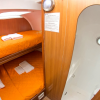Description
Embark on an unforgettable 8-day Galapagos adventure, starting from Baltra and navigating through a diverse array of islands and their unique wildlife. The journey showcases North Seymour’s Blue-Footed Boobies and Magnificent Frigatebirds, offers encounters with sea lions and exotic birds at San Cristobal’s Lobos Island, explores the vibrant marine life of Espanola, and unveils the natural beauty of Floreana’s beaches and historic Post Office Bay. This voyage further presents the giant tortoises of Santa Cruz Highlands and the diverse landscapes of Bartolome and Sullivan Bay on Santiago Island. Highlights include snorkeling amidst vibrant marine species, witnessing the iconic Pinnacle Rock, and admiring the stunning geological formations of Sullivan Bay. This incredible voyage promises an immersive Galapagos experience, culminating in a final circumnavigation of Daphne Island before departure.
Shorter 4 or 5-day voyages are available. Please contact us for more information regarding dates and rates.











